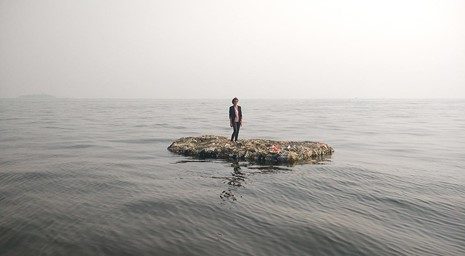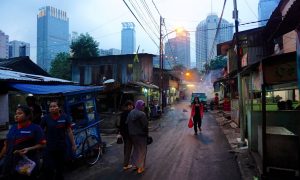Two years ago, the National Gallery of Australia’s Contemporary Worlds: Indonesia exhibition opened to the public. In the third room of the gallery space was a sculpture comprised of one tonne of plastic; wrapped in fishing nets to make an island, and supported by oil barrels and floats. Under the warm glow of an incandescent spotlight, discarded Indonesian candy packets and chip packets and soft drink cans sparkled; deep pinks, pastel blues, greens and gold-tinged wrappers shimmered under the light. There was a feeling of curiosity and surprise that came with encountering rubbish in the fumigated, sanitised gallery space; an aesthetic intervention that combined the out-of-place and the lurid into a strange (but beautiful) harmony.
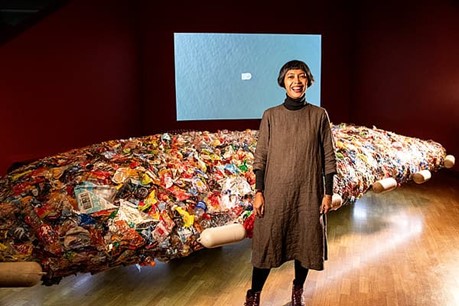
The artist, Tita Salina, standing next to her plastic island at the Contemporary Worlds: Indonesia opening weekend. Image courtesy of the National Gallery of Australia, Canberra
The work of art in question was titled 1001st Island: The Most Sustainable Island in the Archipelago (2015), by the Jakarta-based artist, Tita Salina. The issue of plastic waste is a key topic of concern in the artist’s practice, as well as in works of art produced by—and with— the artist’s frequent collaborator, Irwan Ahmett. In Tita’s claim that this pile of trash is “the most sustainable” island in the archipelago, there is a clear exaggeration and sardonic, tongue-in-cheek comedy; yet the argument is nevertheless true. As the island is made of plastic, it is virtually indestructible. Across the artist’s oeuvre, satire, intervention and dark humour are weaponised to draw attention to key issues that face the world today; and, in 1001st Island, Tita used these tactics to take aim at the issue of sustainability that pervades the country, drawing on performance art and processes of storytelling to tell tales from a sinking, cluttered city.
People, politics and planning collide in riverside slum Kampung Pulo.
Floods and forced evictions in Jakarta
Accompanying the sculptural installation of garbage was a video art projection that documents the construction of this “island”: a two-week, participatory, labour-intensive process, whereby the artist worked with local fishermen from Muara Angke to collect waste from Jakarta Bay. Across both mediums, 1001st Island explores in very clever and lyrical ways the intersections between issues of climate concerns, plastic pollution and rising sea levels that are endemic across the world. But there are also local contexts to this work of art, evident in the never-ending—and in many ways, futile—acts of trying to clean up Jakarta’s coast and rivers when there is too much rubbish. Last year, a ban on single-use plastic bags was introduced in Jakarta for supermarkets, minimarkets and traditional food markets. There is also the ongoing controversy surrounding the proposed, planned “Great Garuda Sea Wall”. And, of course, it is also important to recall Jakarta’s status as the fastest-sinking city on the planet; a significant threat to the livelihoods of many coastal and urban societies.
Through the many processes of action, intervention, artistic documentation, and the production of both video and sculptural works of art, Tita followed the lead of earlier generations of Indonesian artists: “going down below” to sites of struggle and contestation; using art to document and bear witness, and to amplify the concerns of marginalised communities. Later in the video, Tita floats away atop her magical, colourful island paradise, and the landmass of trash becomes her new home. From her position as a citizen of this heaving, teeming megalopolis, Tita put forward a narrative that is in equal parts concerned with the sublime and the sinister; offering visions of a utopian kind, but with glimpses too of a distinctly dystopian future.
1001st Island – The Most Sustainable Island in Archipelago (2015)
Single-channel video: 14:11 minutes, colour, sound.
Produced for Jakarta Biennale (Jakarta, Indonesia), 2015.
Images courtesy of the artist, via YouTube.
In the unfolding narrative of this artwork, there is a distinctly performative, subversive edge that the artist uses to probe and challenge the notion of artificial paradise that Indonesia is so often characterised as being. In the video, the artist immerses herself in the social and environmental landscapes, and, in doing so, draws attention to the hidden realities that slip below the surface image of coastal, sun-drenched getaways. Below the azure island oceans seen on glossy brochures are mounds of plastic waste that float further and further away from their likely origin point: Jakarta.
As Tita drifts to sea in her raft of plastic garbage, her “island” becomes the latest addition to the Kepulauan Seribu chain of islands that lie to the north of Jakarta. This region, referred to by tourists as the “Thousand Islands” is, indeed, comprised of only 110 islands. By asserting her island as the ‘1001st’, Tita turns the image of this chain of islands on its head; intervening and subverting the vision, gaze, and expectation of the “exotic” and “romantic” by instead providing viewers with an island that is satirical, mocking, and subversive. Tita’s raft may well be the 111th island, but, by characterising it as the 1001st, exaggeration and hyperbole dispel any remaining dreamy visions of the landscape, and challenges viewers to see it from a different perspective.
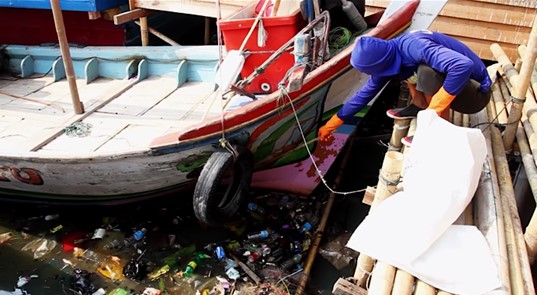
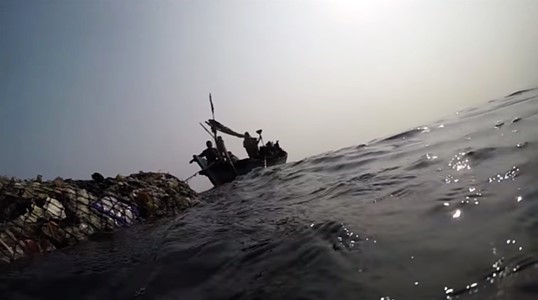
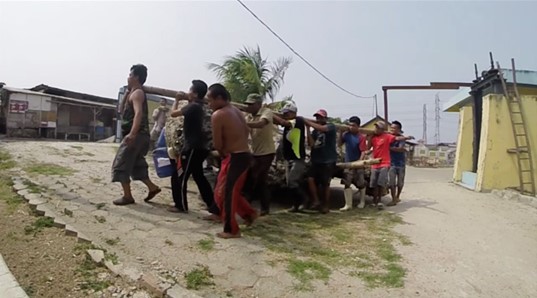
1001st Island: The Most Sustainable Island in the Archipelago (2015) Single-channel video: 14:11 minutes, colour, sound. Produced for Jakarta Biennale (Jakarta, Indonesia), 2015. Images courtesy of the artist, via YouTube
Standing atop the makeshift island of trash, Tita spotlights one of the fundamental paradoxes of this chain of islands: to reach these often private, picturesque, and (seemingly) pristine paradises, you must first cross the sea of garbage found in Jakarta Bay. This is far from a problem that has only occurred in Jakarta and the Kepulauan Seribu; it is an issue that has also manifested in other so-called “island paradises” such as Bali. Although many of the sources of these issues can be found in tourism, it is also—as the artist has pointed out—a broader issue of waste management that pervades many places in the country. Banana leaves, for example, were once used as a common packaging for food in Indonesia: a material that can be discarded outside on the footpath, and which is perfectly biodegradable. As plastic has taken its place as a preferred mode of wrapping, however, the environmental effects have skyrocketed; as Tita notes in the publication Absolute Humidity even though most food products now use plastic wrap, we still have the same habits [in discarding wrappers]”.
In crafting this island of rubbish and collaborating with fishing communities, Tita’s 1001st Island promotes a wider discussion on global issues of waste management and plastic, as well as the view of the island as one of “last resort” in the face of massive environmental and ecological changes. Although the environmental messages of the video resonate with a global audience, Tita speaks through this artwork from the distinct standpoint of a Jakarta citizen addressing local concerns: engaging with communities from a perspective and place that is often overlooked.
From this position, Tita uses art as a tool to confront and visualise difficult environmental and social situations, and proposes a solution—however novel and nonsensical it may be. She engages in acts of subversion, storytelling and satire to draw attention to issues that confront the Jakarta Bay region. Jakarta is a “supermarket of problems”, she comments; but, as a local artist, it is also a “supermarket of inspiration”. With social intervention acting as a common thread across many works in the artist’s oeuvre, 1001st Island invites viewers to consider problems of plastic waste from a perspective that may be unconventional and new, but which is necessary to confront the deeper (and often existential) issues that are facing the region today.
 Facebook
Facebook  Twitter
Twitter  Soundcloud
Soundcloud  Youtube
Youtube  Rss
Rss 